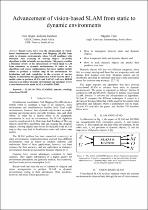JavaScript is disabled for your browser. Some features of this site may not work without it.
- ResearchSpace
- →
- Research Publications/Outputs
- →
- Conference Publications
- →
- View Item
| dc.contributor.author |
Pancham, A

|
|
| dc.contributor.author |
Tlale, N

|
|
| dc.contributor.author |
Bright, G

|
|
| dc.date.accessioned | 2013-01-28T08:51:19Z | |
| dc.date.available | 2013-01-28T08:51:19Z | |
| dc.date.issued | 2012-11 | |
| dc.identifier.citation | Pancham, A, Tlale, N and Bright, G. 2012. Advancement of vision-based SLAM from static to dynamic environments. 19th International Conference on Mechatronics and Machine Vision in Practice (M2VIP12), Auckland, New Zealand, 28-30 November 2012, pp. 192-198 | en_US |
| dc.identifier.uri | http://hdl.handle.net/10204/6481 | |
| dc.description | 19th International Conference on Mechatronics and Machine Vision in Practice (M2VIP12), Auckland, New Zealand, 28-30 November 2012 | en_US |
| dc.description.abstract | Simultaneous Localization And Mapping (SLAM) allows a mobile robot to construct a map of an unknown, static environment and simultaneously localize itself. Real world environments, however, have dynamic objects such as people, doors that open and close, movable furniture, cars, and other robots. In order for a mobile robot to be completely autonomous in such an environment, the SLAM algorithm must be complemented by algorithms that can manage these dynamic objects. Moving objects must be not be included in the SLAM map as they may lead to localization errors and reduce map quality. Recent years, have seen the advancement of vision-based SLAM from static to dynamic environments, where SLAM coupled with Detection And Tracking of Moving Objects (DATMO) algorithms is able to handle moving objects. This paper provides a literature review of the advancement of vision-based SLAM from stationary to dynamic environments. It looks at the algorithms and sensor configurations that have enabled mobile robots to produce a reliable map of the environment for localization and task completion in the presence of moving objects. It determines the algorithms that will be used to allow a mobile robot to perform SLAM and DATMO with two RGB-D cameras in an indoor dynamic environment and concludes where a contribution can be made for SLAM and DATMO. | en_US |
| dc.language.iso | en | en_US |
| dc.relation.ispartofseries | Workflow;9500 | |
| dc.subject | Simultaneous Localization And Mapping | en_US |
| dc.subject | SLAM | en_US |
| dc.subject | Detection And Tracking of Moving Objects | en_US |
| dc.subject | DATMO | en_US |
| dc.subject | Vision-based SLAM | en_US |
| dc.subject | Mobile robots | en_US |
| dc.title | Advancement of vision-based SLAM from static to dynamic environments | en_US |
| dc.type | Conference Presentation | en_US |
| dc.identifier.apacitation | Pancham, A., Tlale, N., & Bright, G. (2012). Advancement of vision-based SLAM from static to dynamic environments. http://hdl.handle.net/10204/6481 | en_ZA |
| dc.identifier.chicagocitation | Pancham, A, N Tlale, and G Bright. "Advancement of vision-based SLAM from static to dynamic environments." (2012): http://hdl.handle.net/10204/6481 | en_ZA |
| dc.identifier.vancouvercitation | Pancham A, Tlale N, Bright G, Advancement of vision-based SLAM from static to dynamic environments; 2012. http://hdl.handle.net/10204/6481 . | en_ZA |
| dc.identifier.ris | TY - Conference Presentation AU - Pancham, A AU - Tlale, N AU - Bright, G AB - Simultaneous Localization And Mapping (SLAM) allows a mobile robot to construct a map of an unknown, static environment and simultaneously localize itself. Real world environments, however, have dynamic objects such as people, doors that open and close, movable furniture, cars, and other robots. In order for a mobile robot to be completely autonomous in such an environment, the SLAM algorithm must be complemented by algorithms that can manage these dynamic objects. Moving objects must be not be included in the SLAM map as they may lead to localization errors and reduce map quality. Recent years, have seen the advancement of vision-based SLAM from static to dynamic environments, where SLAM coupled with Detection And Tracking of Moving Objects (DATMO) algorithms is able to handle moving objects. This paper provides a literature review of the advancement of vision-based SLAM from stationary to dynamic environments. It looks at the algorithms and sensor configurations that have enabled mobile robots to produce a reliable map of the environment for localization and task completion in the presence of moving objects. It determines the algorithms that will be used to allow a mobile robot to perform SLAM and DATMO with two RGB-D cameras in an indoor dynamic environment and concludes where a contribution can be made for SLAM and DATMO. DA - 2012-11 DB - ResearchSpace DP - CSIR KW - Simultaneous Localization And Mapping KW - SLAM KW - Detection And Tracking of Moving Objects KW - DATMO KW - Vision-based SLAM KW - Mobile robots LK - https://researchspace.csir.co.za PY - 2012 T1 - Advancement of vision-based SLAM from static to dynamic environments TI - Advancement of vision-based SLAM from static to dynamic environments UR - http://hdl.handle.net/10204/6481 ER - | en_ZA |






